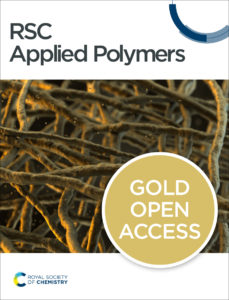RSC Applied Polymers has published its first articles. To celebrate this we wish to introduce some of our #RSCAppliedfirst50 authors and their recently published articles.
In this post we feature authors Professor Jon Pokorski and Mr Samuel Hays for the article ‘Melt Stability of Carbonic Anhydrase in Polyethylene oxide for Extrusion of Protein-Polymer Composite Materials’.
An Introduction to ‘Melt Stability of Carbonic Anhydrase in Polyethylene oxide for Extrusion of Protein-Polymer Composite Materials’ by Samuel Hayes.
In this work, we demonstrate the thermal stability of powdered bovine carbonic anhydrase during melt-processing of polyethylene oxide, (PEO), up to temperatures of 190 °C. Carbonic anhydrase, (CA), is a biologically common enzyme, capable of quickly catalyzing the conversion between CO2 and HCO3–. Carbonic anhydrase is an exciting, biologically friendly tool for CO2 capture. Melt processing, specifically hot melt extrusion, is a manufacturing technique capable of generating products with controlled geometries at massive scale. Melt extruding PEO with dispersed CA into membrane shapes should allow for mass production of functional, enzymatic membranes for CO2 capture.
This work investigates the role of temperature, shear rate, and PEO molecular weight (MW), on the recovery of catalytically active CA following melt processing. Close to 80% of the protein remained active following processing up to 130 °C, regardless of shear stresses and PEO MW. At a temperature of 190 °C, there was a clear increase in protein recovery when increasing PEO MW, with higher PEO MW samples having as much as 40% of initial protein still active. Additionally, the CA recovered had structure and activity of native CA, suggesting non-conjugated, high MW PEO can preserve the enzyme beyond standard protein aggregation temperatures.
The role of PEO in this process is not completely understood, however hypotheses are provided to guide future work as understanding this mechanism can lead to more advanced and scalable carbon capture applications. The feasibility of melt-processing PEO with carbonic anhydrase is very exciting. Membrane materials will be made in future work with the goal of mass producing of enzymatic membranes for CO2 capture.

Samuel Hays
Samuel Hays received his BS in 2018 and MS in 2020 in chemical and biomolecular engineering from Georgia Tech, working with Dr. William Koros on carbon molecular sieve membranes for natural gas purification. In 2020, he joined Dr. Jonathan Pokorski’s group in the Nanoengineering department at UC San Diego, working towards his PhD in chemical engineering. His work focuses on developing biocatalytic membranes for CO2 capture.

Jonathan Pokorski
Professor Pokorski began his career by earning his B.S. in biochemistry from UCLA, while working in private industry designing biomedical devices. Dr. Pokorski received his PhD in chemistry from Northwestern University, where he designed peptidomimetics for use in medical diagnostics and therapeutics. Dr. Pokorski then moved to The Scripps Research Institute as a post-doctoral fellow, where he engineered viral nanoparticles as drug-delivery systems. Pokorski started his independent career at Case Western Reserve University in the Macromolecular Science and Engineering department developing bioconjugate materials. Pokorski’s laboratory at UCSD now works to bridge chemical synthesis, molecular biology, and materials science to make new materials for applications in biomedicine and sustainability. Pokorski’s research has been funded through grants from the NIH, NSF, DOE and ACS. He has been awarded several prestigious awards, including an ACS PRF New Investigator Award and an NIH Pathway to Independence Award. Pokorski currently serves as an IRG lead for the UC San Diego MRSEC.
Samuel S. Hays and Jonathan K. Pokorski
RSC Appl. Polym., 2024, Advance Article. DOI: 10.1039/D3LP00193H
 |
RSC Applied Polymers is a leading international journal for the application of polymers, including experimental and computational studies on both natural and synthetic systems. In this journal, you can discover cross-disciplinary scientific research that leverages polymeric materials in a range of applications. This includes high impact advances made possible with polymers across materials, biology, energy applications and beyond. |



